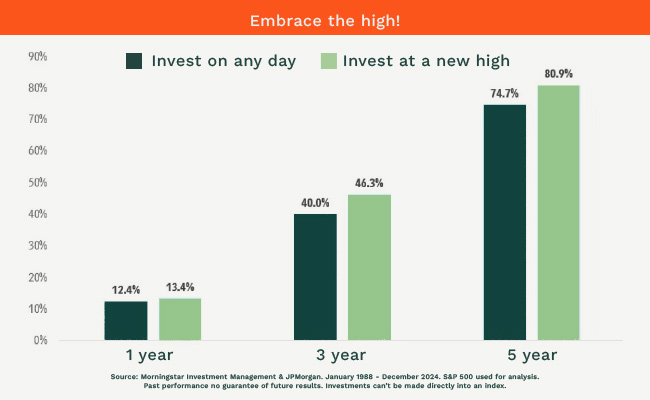Don’t Fear the Peak: New Highs, Old Lessons
If you only read the headlines this year, you’d be restocking the bomb shelter, not your portfolio. Yet the tape tells a different story: companies have grown earnings, profitability has improved and share prices have done the heavy lifting. If you’re waiting for a “better price,” ask yourself how long you can hold your breath. 
The timing temptation
With major global indices back near records and April’s tariff-scare selloff now a distant memory, the familiar questions re-emerge: “Isn’t everything overpriced?” or “Should I sell and buy back after the drop?”
Now, imagine you had a crystal ball on January 1 and knew that:
- Global trade tensions would escalate via punitive tariffs;
- Geopolitical risk would flare up; and
- Unpredictable executive orders from the White House would whipsaw markets.
Most investors would have derisked, bought bonds (maybe some gold too), and sworn off anything sensitive to the rand. That playbook, while emotionally satisfying, would have lagged the outcome we actually got. Markets often react very differently to the news than our instincts predict and even with perfect foresight about events, timing markets is fiendishly hard.
Records aren’t red lights
Counterintuitively, good news can also paralyse action. When prices have “run”, we fear buying the top, which feels like tempting fate. Our instincts protest but the record is plain: episodes like the roughly 25% three-month surge we’ve seen this year are rare and have only occurred a handful of times since the mid-1970s (1975, 1982, 1999, 2009, 2020). What tended to follow? On average, the market was higher three, six and 12 months later, with a rough +21% return for the subsequent year.
The uncomfortable truth is that buying at record highs has, over long periods, still beaten buying on an average day historically. It feels wrong but the data says otherwise. Why bet against the long-term trend when the odds are stacked against you?

Source: Morningstar Investment Management and JPMorgan. January 1988-December 2024.
The takeaway isn’t “it’s different this time”. It’s the opposite. Strong advances after sharp drawdowns don’t automatically mean it’s time to head for the hills; more often, it argues for staying the course in a diversified portfolio. As Morgan Housel put it: “All past declines look like an opportunity; all future declines look like a threat.”
Patience is profitable
None of this is an excuse to ignore price. Valuation is the anchor of long-term returns. Entry point matters, and some shares never reclaim past peaks. But we often overweight the first tick and underweight the next 10 years.
For businesses with long runways, where today’s price discounts growing future cash flows, paying what looked rich at the time has often proved sensible. Titans like Amazon and Microsoft have on numerous past occasions looked expensive, yet rewarded patience as cash flows compounded. The counter examples are just as instructive: Cisco in 2000 or GE in the mid-2000s show that paying any price for poor quality can be costly. The key is to match exposure to quality and time horizon, not to headlines.
For most investors, the practical edge comes from process, not prediction:
- Own a mix you can live with. Diversification blunts the impact of being wrong on any single theme.
- Automate contributions. Regular investing will help you ride out, rather than run from, volatile periods.
- Precommit to your rules. Decide in advance what would make you add, trim or sell, and then let headlines pass without forcing your hand.
Putting it to work
Markets regularly make new highs because, over time, earnings compound. This year alone the S&P 500, Nasdaq 100 and Dow set new records, and the JSE all share cracked 100,000 for the first time. A few months earlier, a 20% slide and a “certain” recession dominated the narrative.
The swing from fear to relief illustrates a permanent truth: there is never a perfect time to invest – only a plan you can stick to. And even if there is, you’ll only know after the fact.
If you’re sitting in cash waiting for the all clear, consider a phased approach into a globally diversified portfolio. If you’re fully invested and nervous, check your allocation and possibly rebalance rather than bolt.
New highs aren’t a stop sign. They’re often a byproduct of improving fundamentals and the market’s habit of looking forward. Manage risk with diversification and valuation awareness, but don’t let “all-time high” be the reason you miss the next leg of compound growth.
Jordan Toy is a private wealth manager who specialises in constructing and managing portfolios with a long-term investment philosophy rooted in business fundamentals and human behaviour. He’s especially interested in how companies create value, and how markets respond over time.
Discover more insights in our blogs
Any opinions, news, research, reports, analyses, prices, or other information contained within this research is provided by an employee of EasyEquities an authorised FSP (FSP no 22588) as general market commentary and does not constitute investment advice for the purposes of the Financial Advisory and Intermediary Services Act, 2002. First World Trader (Pty) Ltd t/a EasyEquities (“EasyEquities”) does not warrant the correctness, accuracy, timeliness, reliability or completeness of any information (i) contained within this research and (ii) received from third party data providers. You must rely solely upon your own judgment in all aspects of your investment and/or trading decisions and all investments and/or trades are made at your own risk. EasyEquities (including any of their employees) will not accept any liability for any direct or indirect loss or damage, including without limitation, any loss of profit, which may arise directly or indirectly from use of or reliance on the market commentary. The content contained within is subject to change at any time without notice.
Any opinions, news, research, reports, analyses, prices, or other information contained within this research is provided by an employee of EasyEquities an authorised FSP (FSP no 22588) as general market commentary and does not constitute investment advice for the purposes of the Financial Advisory and Intermediary Services Act, 2002. First World Trader (Pty) Ltd t/a EasyEquities (“EasyEquities”) does not warrant the correctness, accuracy, timeliness, reliability or completeness of any information (i) contained within this research and (ii) received from third party data providers. You must rely solely upon your own judgment in all aspects of your investment and/or trading decisions and all investments and/or trades are made at your own risk. EasyEquities (including any of their employees) will not accept any liability for any direct or indirect loss or damage, including without limitation, any loss of profit, which may arise directly or indirectly from use of or reliance on the market commentary. The content contained within is subject to change at any time without notice.
Subscribe to our Blog
Search all articles
Posts by topic
- Market News & Events
- Easy Community
- Education
- Dividends Update
- Exchange Traded Funds (ETFs)
- Managed Bundles
- Property Investing
- USD Wallet
- Retirement Annuity (RA)
- Cryptocurrency
- Tax Free Savings Account (TFSA)
- International Investing
- Unit Trusts
- New to Investing
- Artificial Intelligence
- EasyProtect
- Shares
- EasyCredit
- Government Bonds
- New Listings
Let Us Help You, Help Yourself
From how-to’s to whos-whos you’ll find a bunch of interesting and helpful stuff in our collection of videos. Our knowledge base is jam packed with answers to all the questions you can think of.








